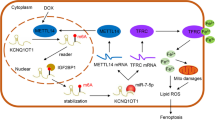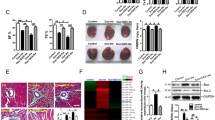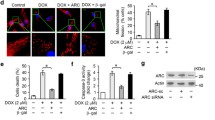Abstract
Although doxorubicin (DOX) is a broad-spectrum and anthracycline chemotherapeutic agent, cardiotoxicity limits its clinical application. Therefore, it is meant to prevent the clinical side effects of DOX. Human cardiomyocyte-like AC16 cells were treated with DOX to induce intracellular toxicity. AC16 cell viability was determined by Cell Counting Kit 8 and 5-ethynyl-2′-deoxyuridine assays. The tumor necrosis factor-α and interleukin-6 abundances were quantified by matched kits. The apoptosis rate was measured by flow cytometry. Western blot analysis was conducted to measure the protein expression levels in AC16 cells. Oxidative stress was analyzed by measuring superoxide dismutase and malondialdehyde production. The quantitative real-time polymerase chain reaction was conducted to assess the expression levels of circ-latent transforming growth factor-beta binding protein-1 (circ-LTBP1), microRNA-107 (miR-107), and Adenylate cyclase 1 (ADCY1) expression in AC16 cells. The interaction relationship among circ-LTBP1, miR-107, and ADCY1 was verified by dual-luciferase reporter and RNA immunoprecipitation assays. As a result, treatment with DOX induced the proliferation inhibition, inflammation, apoptosis, and oxidative stress in AC16 cells, which were rescued by circ-LTBP1 inhibition or miR-107 upregulation. MiR-107 was confirmed as a target of circ-LTBP1, and inhibition of circ-LTBP1-mediated effects on DOX-stimulated cells were abolished by downregulation of miR-107. Circ-LTBP1 mediated ADCY1 expression by sponging miR-107 in AC16 cells. The upregulation of miR-107 increased cell proliferation and inhibited inflammation, apoptosis, and oxidative stress in DOX-stimulated cells through downregulation of ADCY1. Circ-LTBP1 was found to enhance DOX-induced effects on proliferation inhibition, inflammation, apoptosis, and oxidative stress in AC16 cells through competitively sponging miR-107 and elevating ADCY1.








Similar content being viewed by others
Data availability
Not applicable.
Abbreviations
- DOX:
-
Doxorubicin
- EdU:
-
Ethynyl-2′-deoxyuridine
- TGF:
-
Transforming growth factor
- miR-107:
-
MicroRNA-107
- ADCY1:
-
Adenylate cyclase 1
References
Rivankar S (2014) An overview of doxorubicin formulations in cancer therapy. J Cancer Res Ther 10(4):853–858
Speth PA, van Hoesel QG, Haanen C (1988) Clinical pharmacokinetics of doxorubicin. Clin Pharmacokinet 15(1):15–31
Abraham SA, Waterhouse DN, Mayer LD, Cullis PR, Madden TD, Bally MB (2005) The liposomal formulation of doxorubicin. Method Enzymol 391:71–97
Armstrong J, Dass CR (2018) Doxorubicin action on mitochondria: relevance to osteosarcoma therapy? Curr Drug Target 19(5):432–438
Hu C, Zhang X, Wei W, Zhang N, Wu H, Ma Z, Li L, Deng W, Tang Q (2019) Matrine attenuates oxidative stress and cardiomyocyte apoptosis in doxorubicin-induced cardiotoxicity via maintaining AMPKalpha/UCP2 pathway. Acta Pharm Sin B 9(4):690–701
Kristensen LS, Andersen MS, Stagsted LVW, Ebbesen KK, Hansen TB, Kjems J (2019) The biogenesis, biology and characterization of circular RNAs. Nat Rev Genet 20(11):675–691
Panda AC (2018) Circular RNAs act as miRNA sponges. Adv Exp Med Biol 1087:67–79
Sun Y, Jiang X, Lv Y, Liang X, Zhao B, Bian W, Zhang D, Jiang J, Zhang C (2020) Circular RNA expression profiles in plasma from patients with heart failure related to platelet activity. Biomolecules 10(2):187
Lu TX, Rothenberg ME (2018) MicroRNA. J Allergy Clin Immunol 141(4):1202–1207
Bushati N, Cohen SM (2007) MicroRNA functions. Annu Rev Cell Dev Biol 23:175–205
Liang Y, Zhu D, Hou L, Wang Y, Huang X, Zhou C, Zhu L, Wang Y, Li L, Gu Y et al (2020) MiR-107 confers chemoresistance to colorectal cancer by targeting calcium-binding protein 39. Br J Cancer 122(5):705–714
Zhang Z, Zhang L, Yin ZY, Fan XL, Hu B, Wang LQ, Zhang D (2014) miR-107 regulates cisplatin chemosensitivity of A549 non small cell lung cancer cell line by targeting cyclin dependent kinase 8. Int J Clin Exp Pathol 7(10):7236–7241
Su PF, Song SQ (2018) Regulation of mTOR by miR-107 to facilitate glioma cell apoptosis and to enhance cisplatin sensitivity. Eur Rev Med Pharmacol Sci 22(20):6864–6872
Teng R, Hu Y, Zhou J, Seifer B, Chen Y, Shen J, Wang L (2015) Overexpression of lin28 decreases the chemosensitivity of gastric cancer cells to oxaliplatin, paclitaxel, doxorubicin, and fluorouracil in part via microRNA-107. PLOS One 10(12):e0143716
Rosenbaum DM, Rasmussen SG, Kobilka BK (2009) The structure and function of G-protein-coupled receptors. Nature 459(7245):356–363
Bohm M, Schwinger RH, Erdmann E (1990) Alterations of the cAMP-adenylate cyclase system in the failing human heart. Consequences for the therapy with inotropic drugs. Klin Wochenschr 68(18):887–895
Zou T, Liu J, She L, Chen J, Zhu T, Yin J, Li X, Li X, Zhou H, Liu Z (2019) A perspective profile of ADCY1 in cAMP signaling with drug-resistance in lung cancer. J Cancer 10(27):6848–6857
Zhang X, Poniewierski A, Sozanski K, Zhou Y, Brzozowska-Elliott A, Holyst R (2019) Fluorescence correlation spectroscopy for multiple-site equilibrium binding: a case of doxorubicin-DNA interaction. Phys Chem Chem Phys 21(3):1572–1577
Zhou ZB, Huang GX, Fu Q, Han B, Lu JJ, Chen AM, Zhu L (2019) circRNA. 33186 contributes to the pathogenesis of osteoarthritis by sponging miR-127-5p. Mol Ther 27(3):531–541
Pan JA, Tang Y, Yu JY, Zhang H, Zhang JF, Wang CQ, Gu J (2019) miR-146a attenuates apoptosis and modulates autophagy by targeting TAF9b/P53 pathway in doxorubicin-induced cardiotoxicity. Cell Death Dis 10(9):668
Liu YQ, Yang M, Duan CH, Su GB, Wang JH, Liu YF, Zhang J (2014) Protective role of neuregulin-1 toward doxorubicin-induced myocardial toxicity. Genet Mol Res 13(2):4627–4634
Shi J, Ren Y, Liu Y, Cheng Y, Liu Y (2021) Circulating miR-3135b and miR-107 are potential biomarkers for severe hypertension. J Hum Hypertens 35(4):343–350
Wang Z, Zhuang X, Chen B, Feng D, Li G, Wei M (2020) The Role of miR-107 as a potential biomarker and cellular factor for acute aortic dissection. DNA Cell Biol 39(10):1895–1906
Sun L, Zhang T, Xiu W, Cao W, He M, Sun W, Zhao W (2020) MiR-107 overexpression attenuates neurotoxicity induced by 6-hydroxydopamine both in vitro and in vivo. Chem Biol Interact 315:108908
Ke S, Yang Z, Yang F, Wang X, Tan J, Liao B (2019) Long noncoding RNA NEAT1 aggravates abeta-induced neuronal damage by targeting miR-107 in Alzheimer’s disease. Yonsei Med J 60(7):640–650
Cheng J, Wang G, Zhang N, Li F, Shi L, Li H (2020) Isovitexin modulates autophagy in Alzheimer’s disease via miR-107 signalling. Transl Neurosci 11(1):391–401
Zhuang Y, Wang S, Fei H, Ji F, Sun P (2020) miR-107 inhibition upregulates CAB39 and activates AMPK-Nrf2 signaling to protect osteoblasts from dexamethasone-induced oxidative injury and cytotoxicity. Aging (Albany NY) 12(12):11754–11767
Kim HW, Mallick F, Durrani S, Ashraf M, Jiang S, Haider KH (2012) Concomitant activation of miR-107/PDCD10 and hypoxamir-210/Casp8ap2 and their role in cytoprotection during ischemic preconditioning of stem cells. Antioxid Redox Signal 17(8):1053–1065
Rech M, Kuhn AR, Lumens J, Carai P, van Leeuwen R, Verhesen W, Verjans R, Lecomte J, Liu Y, Luiken J et al (2019) AntagomiR-103 and -107 treatment affects cardiac function and metabolism. Mol Ther Nucleic Acids 14:424–437
Beaumier A, Robinson SR, Robinson N, Lopez KE, Meola DM, Barber LG, Bulmer BJ, Calvalido J, Rush JE, Yeri A et al (2020) Extracellular vesicular microRNAs as potential biomarker for early detection of doxorubicin-induced cardiotoxicity. J Vet Intern Med 34(3):1260–1271
Ma M, Dai J, Tang H, Xu T, Yu S, Si L, Cui C, Sheng X, Chi Z, Mao L et al (2019) MicroRNA-23a-3p inhibits mucosal Melanoma growth and progression through targeting adenylate cyclase 1 and attenuating cAMP and MAPK pathways. Theranostics 9(4):945–960
Chen J, Wu F, Shi Y, Yang D, Xu M, Lai Y, Liu Y (2019) Identification of key candidate genes involved in melanoma metastasis. Mol Med Rep 20(2):903–914
Ruan X, Chen T, Wang X, Li Y (2017) Suxiao Jiuxin Pill protects cardiomyocytes against mitochondrial injury and alters gene expression during ischemic injury. Exp Ther Med 14(4):3523–3532
Wang X, Cheng Z, Xu J, Feng M, Zhang H, Zhang L, Qian L (2021) Circular RNA Arhgap12 modulates doxorubicin-induced cardiotoxicity by sponging miR-135a-5p. Life Sci 265:118788
Acknowledgements
None.
Funding
None.
Author information
Authors and Affiliations
Contributions
LZ and XB designed and performed the research; JW, LL and ZY analyzed the data; CL wrote the manuscript. All authors read and approved the final manuscript.
Corresponding author
Ethics declarations
Conflict of interest
The authors declare that they have no conflicts of interest.
Ethical approval
The research has been carried out in accordance with the World Medical Association Declaration of Helsinki, and that all subjects provided written informed consent.
Informed consent
Written informed consents were obtained from all participants and this study was permitted by the Ethics Committee of Shanxi Bethune Hospital, Shanxi Medical University Third Hospital.
Consent for publication
Not applicable.
Additional information
Publisher's Note
Springer Nature remains neutral with regard to jurisdictional claims in published maps and institutional affiliations.
Supplementary Information
Below is the link to the electronic supplementary material.
Rights and permissions
About this article
Cite this article
Li, C., Zhang, L., Bu, X. et al. Circ-LTBP1 is involved in doxorubicin-induced intracellular toxicity in cardiomyocytes via miR-107/ADCY1 signal. Mol Cell Biochem 477, 1127–1138 (2022). https://doi.org/10.1007/s11010-022-04360-0
Received:
Accepted:
Published:
Issue Date:
DOI: https://doi.org/10.1007/s11010-022-04360-0




